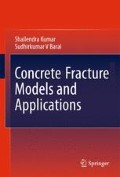Abstract
It is well known that all important nonlinear fracture models can capture adequately the structural size effect over the useful range of applicability. The size-effect study of various fracture parameters obtained from two-parameter fracture model, size-effect model, effective crack model, double-K fracture model, and double-G fracture model with respect to fictitious crack model is presented in this chapter. To this end, different fracture parameters from size-effect model, effective crack model, double-K fracture model, and double-G fracture model are evaluated using standard procedures for which the input data are obtained from fictitious crack model for three-point bending test. In addition, the fracture parameters of two-parameter fracture model are obtained using the mathematical coefficients available in literature. From the study it is observed that the fracture parameters obtained from various nonlinear fracture models including the double-K and double-G fracture parameters are influenced by the specimen size. These fracture parameters maintain some definite interrelationship depending upon the specimen size and the relative size of initial notch length.
Access this chapter
Tax calculation will be finalised at checkout
Purchases are for personal use only
References
Karihaloo BL, Nallathambi P (1990) Size-effect prediction from effective crack model for plain concrete. Mater Struct 23 (3): 178–185.
Karihaloo BL, Nallathambi P (1991) Notched beam test: Mode I fracture toughness. Fracture Mechanics Test Methods for Concrete. Report of RILEM Technical Committee 89-FMT (Edited by SP Shah, A Carpinteri), London, Chapman & Hall: 1–86.
Kumar S (2010) Behaviour of fracture parameters for crack propagation in concrete. Ph.D. Thesis submitted to Department of Civil Engineering, Indian Institute of Kharagpur, India.
Kumar S, Barai SV (2008) Influence of specimen geometry on determination of double-K fracture parameters of concrete: A comparative study. Int J Fract 149: 47–66.
Kumar S, Barai SV (2009a) Equivalence between stress intensity factor and energy approach based fracture parameters of concrete. Eng Fract Mech 76: 1357–1372.
Kumar S, Barai SV (2009b) Size-effect of fracture parameters in concrete: A comparative study. Comput Concr Int J (under review).
Kumar S, Barai SV (2010) Size-effect prediction from the double-K fracture model for notched concrete beam. Int J Damage Mech 9: 473–497.
MATLAB Version 7, The MathWorks, Inc., Copyright 1984–2004.
Planas J, Elices M (1990) Fracture criteria for concrete: Mathematical validations and experimental validation. Eng Fract Mech 35: 87–94.
RILEM Draft Recommendations (TC89-FMT) (1990a) Determination of fracture parameters (KIc s and CTODc) of plain concrete using three-point bend tests, proposed RILEM draft recommendations. Mater Struct 23 (138): 457–460.
RILEM Draft Recommendations (TC89-FMT) (1990b) Size-effect method for determining fracture energy and process zone size of concrete. Mater Struct 23 (138): 461–465.
Tada H, Paris PC, Irwin G (1985) The Stress Analysis of Cracks Handbook. Hellertown, PA, Del Research Corporation.
Xu S, Reinhardt HW (1999) Determination of double-K criterion for crack propagation in quasi-brittle materials, Part II: Analytical evaluating and practical measuring methods for three-point bending notched beams. Int J Fract 98: 151–177.
Xu S, Zhang X (2008) Determination of fracture parameters for crack propagation in concrete using an energy approach. Eng Fract Mech 75: 4292–4308.
Author information
Authors and Affiliations
Corresponding author
Rights and permissions
Copyright information
© 2011 Springer -Verlag Berlin Heidelberg
About this chapter
Cite this chapter
Kumar, S., Barai, S.V. (2011). Comparison of Fracture Parameters of Concrete Using Nonlinear Fracture Models. In: Concrete Fracture Models and Applications. Springer, Berlin, Heidelberg. https://doi.org/10.1007/978-3-642-16764-5_6
Download citation
DOI: https://doi.org/10.1007/978-3-642-16764-5_6
Published:
Publisher Name: Springer, Berlin, Heidelberg
Print ISBN: 978-3-642-16763-8
Online ISBN: 978-3-642-16764-5
eBook Packages: EngineeringEngineering (R0)

